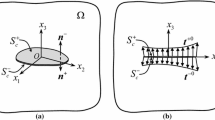Abstract
The second boundary value problem of elasticity for 3D-bodies containing cracks is considered. Presentation of the solution in the form of the double layer potential reduces the problem to a system of 2D-integral equations which kernels are similar for the body boundary and crack surfaces. For discretization of these equations, Caussian approximation functions centered at a set of nodes homogeneously distributed on the body and crack surfaces are used. For such functions, calculation of the elements of the matrix of the discretized problem is reduced to five standard 1D-integrals that can be tabulated. For planar cracks, these integrals are calculated in closed analytical forms. The method is mesh free, and for its performing, only node coordinates and surface orientations at the nodes should be defined. Calculation of stress intensity factors at the crack edges in the framework of the method is discussed. Examples of an elliptical crack, a lens-shaped crack, and a spherical body subjected to concentrated and distributed surface forces are considered. Numerical results are compared with the solutions of other authors presented in the literature. Convergence of the method with respect to the node grid steps is analyzed. An efficient algorithm of the node grid generation is proposed.




















Similar content being viewed by others
References
Alexandrov A, Soloviev Yu (1978) Three dimensional problems of elasticity. Nauka, Moscow (in Russian)
Barbieri E, Petrinic N, Meo M, Tagarielli V (2012) A new weight-function enrichment in meshless method for multiple cracks in linear elasticity. Int J Numer Methods Eng 90:177–195
Cruse T (1988) Boundary element analysis in computational fracture mechanics. Kluwer, Dordrecht
Duflot M (2006) A meshless method with enriched weight functions for three-dimensional crack propagation. Int J Numer Methods Eng 65:1970–2006
Farhat C, Harrari I, Franca LP (2001) The discontinuous enrichment method. Comput Methods Appl Mech Eng 190:6455–6479
Farhat C, Harrari I, Hetmaniuk U (2003) The discontinuous enrichment method for multiscale analysis. Comput Methods Appl Mech Eng 192:3195–3209
Gosz M, Moran B (2002) An interaction energy integral method for computation of mixed-mode stress intensity factors along nonplanar crack fronts in three dimensions. Eng Fract Mech 69:299–319
Kanaun S (1981) Elastic problem for 3D-anisotropic medium with a crack. Appl Math Mech (PMM) 45:361–370
Kanaun S (2007) Fast solution of the 3D elasticity problem for a planar crack of arbitrary shape. Int J Fract 148:435–442
Kanaun S, Levin V (2008) Self-consistent methods for composites I, static problems, SMIA, 148. Springer, Dordrecht
Kanaun S, Romero V, Bernal J (2001) A new numerical method for the solution of the second boundary value problem of elasticity for bodies with cracks. Revista Mexicana de Física 47(4):309–323
Kunin I (1983) The theory of elastic media with microstructure II. Springer, Berlin
Mal A, Singh S (1991) Deformation of elastic solids. Prentice Hall, New Jersey
Maz’ya V, Schmidt G (2007) Approximate approximation, AMS, 141. Mathematical Surveys and Monographs, Providence
Press W, Flannery B, Teukolsky S, Wetterling W (1992) Numerical recipes in FORTRAN: the art of scientific computing. Cambridge University Press, Cambridge
Rabczuk T, Areias P, Belytschko T (2004) Cracking particles: a simplified meshfree method for arbitrary evolving cracks. Int J Numer Methods Eng 61:2316–2343
Simpson R, Trevelyan J (2011) A partition of unity enriched dual boundary element method for accurate computations in fracture mechanics. Comput Methods Appl Mech Eng 200:1–10
Simpson R, Bordas S, Lian H, Trevelyan (2013) An isogeometric boundary element mothod for elastostatic analysis: 2D implementation aspects. comput struct 118:2–12
Author information
Authors and Affiliations
Corresponding author
Appendix
Appendix
Let a smooth surface \(\Omega \) in 3D-space be described by an implicit equation
For generation of a homogeneous node grid on this surface, an arbitrary point \(\mathbf {x}\in \Omega \) is to be taken as an original node \(\mathbf {x} ^{(1)}.\) The next node \(\mathbf {x=x}^{(2)}\) is any solution of the equations
The third node \(\mathbf {x=x}^{(3)}\) is one of the two solutions of the following equations
For calculation of the coordinates of the \(s\)th node \(\mathbf {x=x}^{(s)} ( s=4,5,\ldots )\), we consider the system of equations
Among the solutions \(\mathbf {x}=\mathbf {x}_{m}^{(s)}\) of this system we chose the one \(\mathbf {x}^{(s)}\) that satisfies the conditions
In the case of a planar crack, this algorithm leads to a regular hexagonal node grid on the crack plane. For a spherical surface, an example of the generated node grid is presented in Fig. 21. The centers of small spheres shown in this figure compose a set of approximating nodes. Some defects of the grid where the distances between the neighbor nodes are more than \(h\) do not affect practically the quality of the solution for sufficiently small grid steps \(h\).
Rights and permissions
About this article
Cite this article
Kanaun, S., Markov, A. & Babaii, S. An efficient numerical method for the solution of the second boundary value problem of elasticity for 3D-bodies with cracks. Int J Fract 183, 169–186 (2013). https://doi.org/10.1007/s10704-013-9885-5
Received:
Accepted:
Published:
Issue Date:
DOI: https://doi.org/10.1007/s10704-013-9885-5





